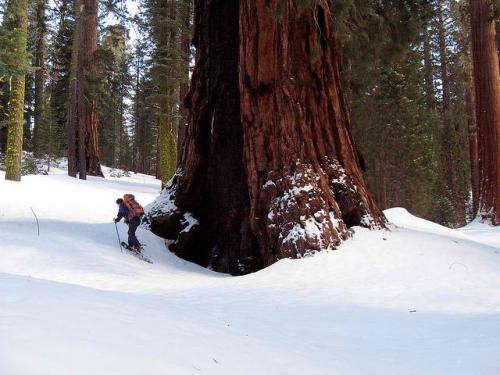Snowshoes are your ticket for wilderness-friendly winter recreation

A Snowshoer enjoys winter recreation in Mariposa Grove, Yosemite National Park.
Flikr creative commons: maria chily
There’s nothing quite like venturing into a breathtaking winter wonderland - and then feeling your feet sink into drifts of snow that are knee to waist deep. This is one of the reasons why snowshoes are an outdoor recreationist's best friend. But using snowshoes goes well beyond convenience. Here are just a few of the reasons why snowshoeing is one of the best ways to experience wilderness and our public lands in winter:
1. Experience any landscape. Snowshoes allow you to visit all kinds of incredible places in winter, including terrain that has any amount of snow or is woody or rocky. You can continue to delight public lands during the snowy season, whether you visit a wildlife refuge or a snowy National Park like Lassen, Glacier, Rocky Mountain, Denali, Mt. Rainier, or Olympic. Search recreation.gov for ideal places near you.
2. Reduce your snowprint. As long as you follow leave no trace principles, snowshoeing has minimal impact on the wilderness we work to protect, especially since unlike other winter sports it doesn't involve development of infrastructure. Keeping lands undisturbed means we are able to enjoy the cherished solitude and peace that this recreation can offer.
3. Learn with ease - get hurt less. Unlike skiing and snowboarding, snowshoeing can be learned very quickly but does not involve as much injury. As they say, if you can walk, you can snowshoe!
4. Stay active outdoors - and fend off illness. Snowshoeing is a fun wilderness-centered activity that will motivate you to combat winter blues through recreation. It is a low impact, aerobic sport that burns more calories than merely walking or running, and can help you fight off colds.
5. Spot animals – and follow their lead. Snow offers unique opportunities to see wildlife tracks, and snowshoes allow you to walk right alongside them for unexpected adventures. You can contact a wildlife department in your state for information on local animal tracks, or take it a step further and do some citizen science in the field.
6. Save cash. This sport is one of the most affordable winter activities by far. Shoes are generally your only expense, and you can either rent them for about $20 a day or buy a used or new pair for $100-200. You can even try to make some yourself if you’re feeling crafty.
7. Go at your own pace. Snowshoeing is fantastically versatile as a great activity for leisure, fitness as well as more challenging backcountry wilderness adventures. However you choose to participate, snowshoeing can be an excellent way to recreate outdoors during the snowy season!
Getting started with snowshoeing
- Pick up a pair of shoes: either rent some to try it out or invest in purchasing a used or new pair.
- Go to recreation.gov to find public lands near you where you can test your new shoes.
- Wear or bring boots, hat, gloves, warm layers, food, water, map, compass and, if you'd like, poles.
- Stay on and share trails with backcountry skiers.
- You may want to get a quick tutorial on safely climbing and descending hills.
